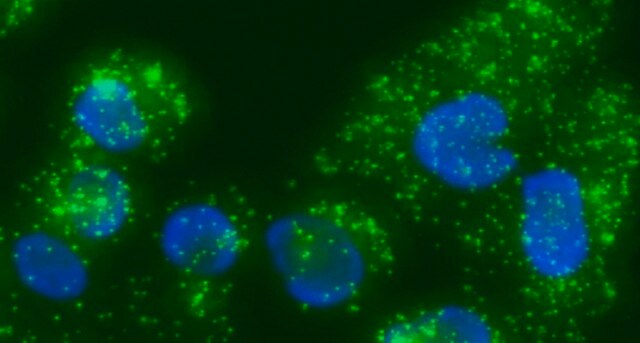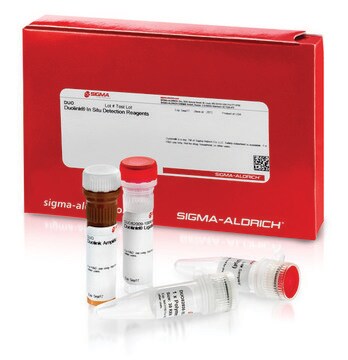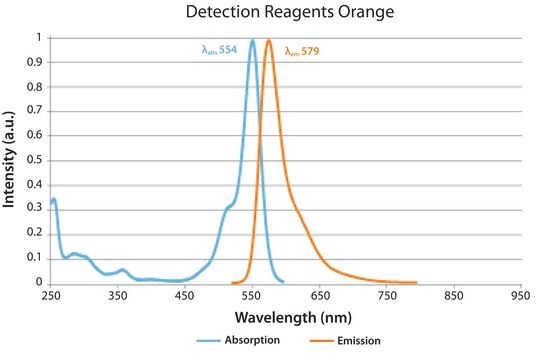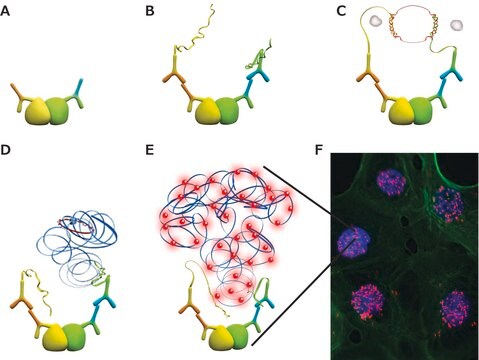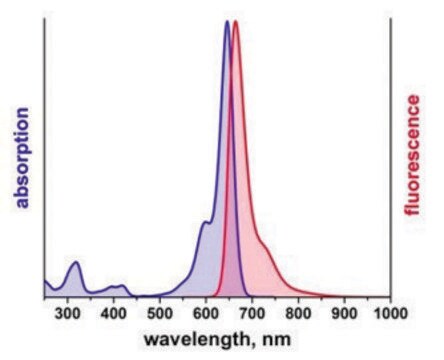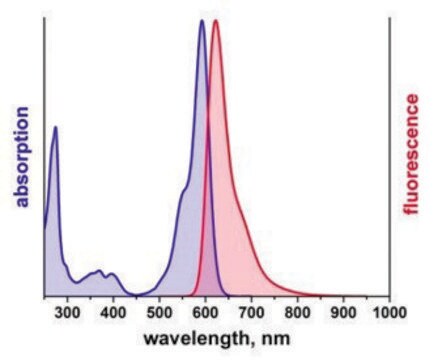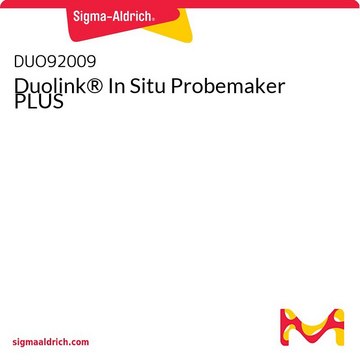DUO92101
Duolink® In Situ Red Starter Kit Mouse/Rabbit
Synonym(s):
in situ Proximity Ligation Assay, Protein Protein Interaction Assay
About This Item
Recommended Products
product line
Duolink®
Quality Level
technique(s)
proximity ligation assay: suitable
fluorescence
λex 594 nm; λem 624 nm (Texas Red®; Zeiss Filter set 31)
suitability
suitable for fluorescence
storage temp.
−20°C
Related Categories
Application
Follow the Duolink® In Situ Fluorescence Protocol to use this product. A set of short instructionsis also available.
Visit our Duolink® PLA Resource Center for information on how to run a Duolink® experiment, applications, troubleshooting, and more.
To perform a complete Duolink® PLA in situ experiment you will need two primary antibodies (PLA, IHC, ICC or IF validated) that recognize two target epitopes.This starter kit supplies all other necessary reagents for 30 Duolink® PLA reactions, which include a pair of PLA probes (Anti-Rabbit PLUS and Anti-Mouse MINUS), red detection reagents, wash buffers, and mounting medium. Note that the primary antibodies must come from the same species as the Duolink® PLA probes. Analysis is carried out using standard immunofluorescence assay equipment.
The Duolink® In Situ Red Starter Kit Mouse/Rabbit requires one primary antibody from mouse and one primary antibody from rabbit. Red fluorescence detection reagents are often used with Texas Red® filter.
Application Note
Two primary antibodies raised in different species are needed. Test your primary antibodies (IgG-class, mono- or polyclonal) in a standard immunofluorescence (IF), immunohistochemistry (IHC) or immunocytochemistry (ICC) assay to determine the optimal fixation, blocking, and titer conditions. Duolink® PLA in situ reagents are suitable for use on fixed cells, cytospin cells, cells grown on slide, formalin-fixed, paraffin embedded (FFPE), or tissue (fresh or frozen). No minimum number of cells is required.
Let us do the work for you, learn more about our Custom Service Program to accelerate your Duolink® projects
View full Duolink® product list
Features and Benefits
- No overexpression or genetic manipulation required
- High specificity (fewer false positives)
- Single molecule sensitivity due to rolling circle amplification
- Relative quantification possible
- No special equipment needed
- Quicker and simpler than FRET
- Increased accuracy compared to co-IP
- Publication-ready results
Legal Information
Kit Components Also Available Separately
- DUO92002Duolink® In Situ PLA® Probe Anti-Rabbit PLUS, Affinity purified Donkey anti-Rabbit IgG (H+L)SDS
- DUO92004Duolink® In Situ PLA® Probe Anti-Mouse MINUS, Affinity purified Donkey anti-Mouse IgG (H+L)SDS
- DUO92008Duolink® In Situ Detection Reagents RedSDS
- DUO82049Duolink® In Situ Wash Buffers, FluorescenceSDS
- DUO82040Duolink® In Situ Mounting Medium with DAPISDS
Signal Word
Danger
Hazard Statements
Precautionary Statements
Hazard Classifications
Aquatic Chronic 2 - Met. Corr. 1 - Resp. Sens. 1 - Skin Sens. 1
Storage Class Code
8A - Combustible corrosive hazardous materials
Choose from one of the most recent versions:
Certificates of Analysis (COA)
It looks like we've run into a problem, but you can still download Certificates of Analysis from our Documents section.
If you need assistance, please contact Customer Support.
Already Own This Product?
Find documentation for the products that you have recently purchased in the Document Library.
Customers Also Viewed
Articles
Learn how Proximity Ligation Assay technology works and how the protein-protein interaction control kit can confirm in situ detection of EGF-induced EGFR-HER2 dimerization.
Duolink® proximity ligation assay used to study neuron interactions furthering neuroscience research.
Find Duolink references based on the type of method used, post translational modification detected, and research focus.
Related Content
Protein and nucleic acid interaction reagents and resources for investing protein-RNA, protein-DNA, and protein-protein interactions and associated applications.
Global Trade Item Number
| SKU | GTIN |
|---|---|
| DUO92101-1KT | 4061833592199 |
Our team of scientists has experience in all areas of research including Life Science, Material Science, Chemical Synthesis, Chromatography, Analytical and many others.
Contact Technical Service
